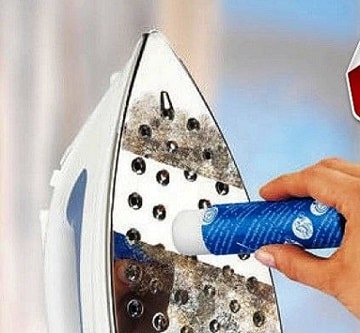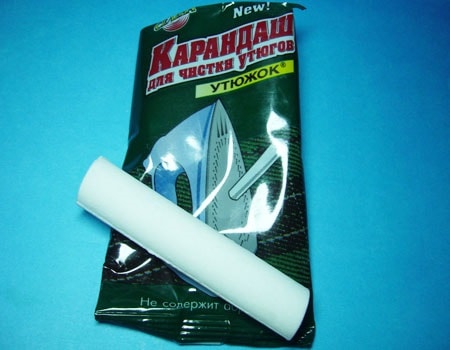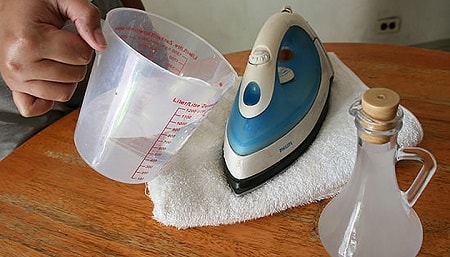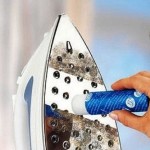 Sooner or later, but in the process of use, all dirt, dust and fabric particles adhere to the iron (to its ironing surface), as a result of which carbon deposits are formed, which sharply impairs slipping and makes it impossible to use the ironing device normally. This raises the question of how and how to clean a Teflon-coated iron, ceramic or metal from carbon deposits. Household chemical stores have a huge selection of different cleaning products for such occasions. But we will talk about improvised, home remedies and ways to clean the soles from burns. We will tell you about how to clean an iron at home with penny means, while quickly and efficiently.
Sooner or later, but in the process of use, all dirt, dust and fabric particles adhere to the iron (to its ironing surface), as a result of which carbon deposits are formed, which sharply impairs slipping and makes it impossible to use the ironing device normally. This raises the question of how and how to clean a Teflon-coated iron, ceramic or metal from carbon deposits. Household chemical stores have a huge selection of different cleaning products for such occasions. But we will talk about improvised, home remedies and ways to clean the soles from burns. We will tell you about how to clean an iron at home with penny means, while quickly and efficiently.
Cleaning the iron from carbon deposits at home
The first commercial iron cleaner that can be purchased at any hardware store is a special cleaning pencil that looks like an ordinary stearic candle. It costs mere pennies, so you can buy several such pencils in advance and not rack your brains when you need it.
This pencil is very easy to use. But still, we will give detailed instructions on how to clean the iron from carbon deposits at home using a pencil.
- We warm up the sole to 140 degrees (this is the mode for ironing woolen fabrics).
- Take a firm grip on the opposite end of the pencil.
- Pick up the hot iron in such a way that the sole is turned away from you.
- Rub the dirty places on the sole with a pencil, while all the scale should turn into a dirty molten liquid, which must be removed with an unnecessary rag spread out on the table. This rag will have to be thrown away.
- We work carefully so as not to burn ourselves, and so as not to inhale the smoke that will come as a result of the chemical reaction of the ingredients of the pencil with hot carbon deposits. Manufacturers assure that this smoke does not contain any poisonous substances and is absolutely safe, but you should not tempt fate.
- To clean the steam holes in which carbon deposits have accumulated, you just need to bring a pencil to the holes during steam generation. You will be surprised, but the dirt from the steam holes will be removed, as if by magic. With a pencil, you can clean the iron at home from carbon deposits even in inaccessible places, and this is not difficult.
- After cleaning the soleplate, which takes only a few minutes, the iron should be turned off and rinsed from the remains of chemicals in a cooled state.
In the end, you will be able to see how effective the pencil is. The ironing surface will become mirror-like again and perfectly smooth, easily sliding over any fabric. An important nuance - the composition of the pencil does not include abrasive particles, so you can clean the ironing surface, even if it has a thin coating.
![]() See also - How to remove iron marks on clothes
See also - How to remove iron marks on clothes

The second simple but effective way is to clean the iron with vinegar. It can be used to clean carbon deposits, burnt fabrics, limescale (scale) and other dirt on the sole.To clean with vinegar, we also need cotton pads and swabs, which can be purchased at any store that sells cosmetics and hygiene products. So, here's a quick guide on how to remove carbon deposits with edible vinegar.
- The iron should be slightly warmed up, as for ironing delicate fabrics.
- Soak a cotton pad with vinegar, but not enough to drain the vinegar.
- For greater safety, you can work with cotton swabs, or take the disc with tweezers. Apply a damp disc to the entire contaminated surface. The burn may not be removed from the first treatment, then the procedure must be repeated in order to finally remove the plaque. Processing should be carried out in a circular motion.
- Be especially careful when cleaning with vinegar in the steam holes. This is done with cotton swabs and so that the vinegar in no case flows into the holes, for which it is better to hold the iron in a canopy, with the sole down.
- Each time after treatment with vinegar, you need to iron a cotton rag, on which the dissolved burn should remain. In this way, you can clean Teflon, ceramic coated and metal soles, but this should be done carefully, as sometimes the coating is destroyed from an excess of vinegar.

If the carbon is very strong, you can use ammonia instead of vinegar. They wipe cold surfaces with it, and then turn on the heating. After warming up, iron the cotton fabric, while pressing hard.
Many people ask how to clean the iron from adhering polyethylene, and what types of home remedies can cope with this type of burn. This is a really tough case, and in such cases, nail polish remover or acetone is required to dissolve and wash off the carbon deposits.
![]() See also - How to clean the iron from scale inside
See also - How to clean the iron from scale inside
Traditional methods of cleaning the iron
Necessity for invention is tricky, and every housewife knows several ways how you can wipe off the burn with improvised home remedies in case there are no purchased ones, and the iron needs urgent cleaning. We list the most common ways
- Candle. Many people say that carbon deposits can be easily removed with a paraffin candle and the effect is almost the same as from a pencil. The technique and algorithm of actions is exactly the same as with a pencil, only it is advisable to wrap the candle with a rag so as not to burn yourself.
- Salt. Even the most stubborn dirt can be removed with it. The thicker the deposit, the larger the salt needs to be used. It is evenly poured onto a layer of fabric or paper and ironed with good pressure with a very hot sole. This is done until the surface is completely cleaned.
- Baking soda. You can effectively remove carbon deposits with baking soda. To do this, dissolve a small amount of salt in water. Moisten a cotton swab generously with a soda solution and treat the cold sole with it. As a result, carbon deposits soften and should be easily removed with a regular cloth.
- Laundry soap. Effectively removes fresh stains that have just appeared. You need to rub these stains on the cold sole with soap and wipe with a cloth.
![]() See also - Which steamer for clothes and curtains to choose?
See also - Which steamer for clothes and curtains to choose?
Tips for correct use
- Every time the iron cools down, wipe it with a damp cloth. If melted synthetic fabric is stuck to it, then it must be removed with acetone or nail polish remover after cooling.
- We do not recommend cleaning the ironing surfaces with emery paper, abrasive substances or cleaning with iron wool. Such a harsh effect will definitely leave scratches on the ironing surface.
- It is necessary to iron cotton and linen fabrics from the front side, this has a positive effect on the quality of the fabric.
- Silk fabrics should be ironed dry, slightly damp, or turn on the steamer.
- It is prohibited to iron velor and velvet on the ironing board.
- The steamer should be filled with the purest water possible, ideally distilled.
In this article, we described how and how to clean the iron from carbon deposits and burnt fabrics using chemicals and effective methods of housewives. The most important thing is to understand once and for all that coarse abrasives cannot be used to clean the Teflon sole of the iron, as this leads to damage to the smooth surface and the appearance of even greater problems in the future.
See also:


